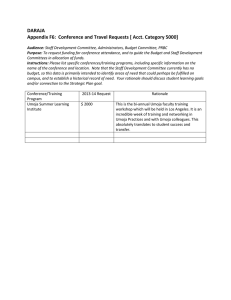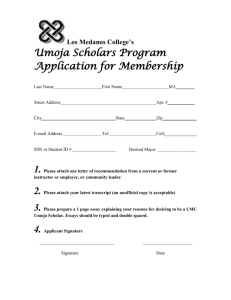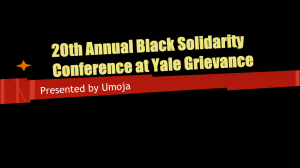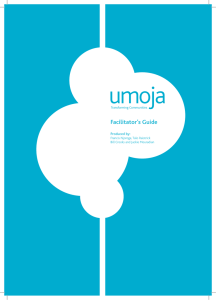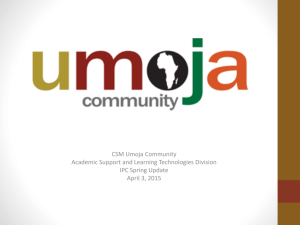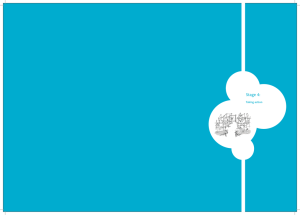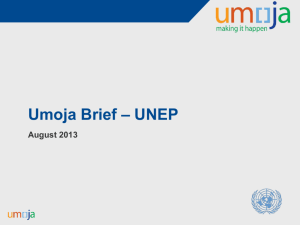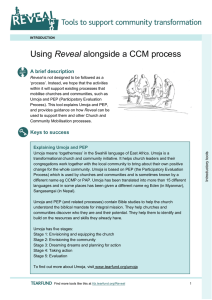College Mission and Diversity Statements: Mission Statement
advertisement
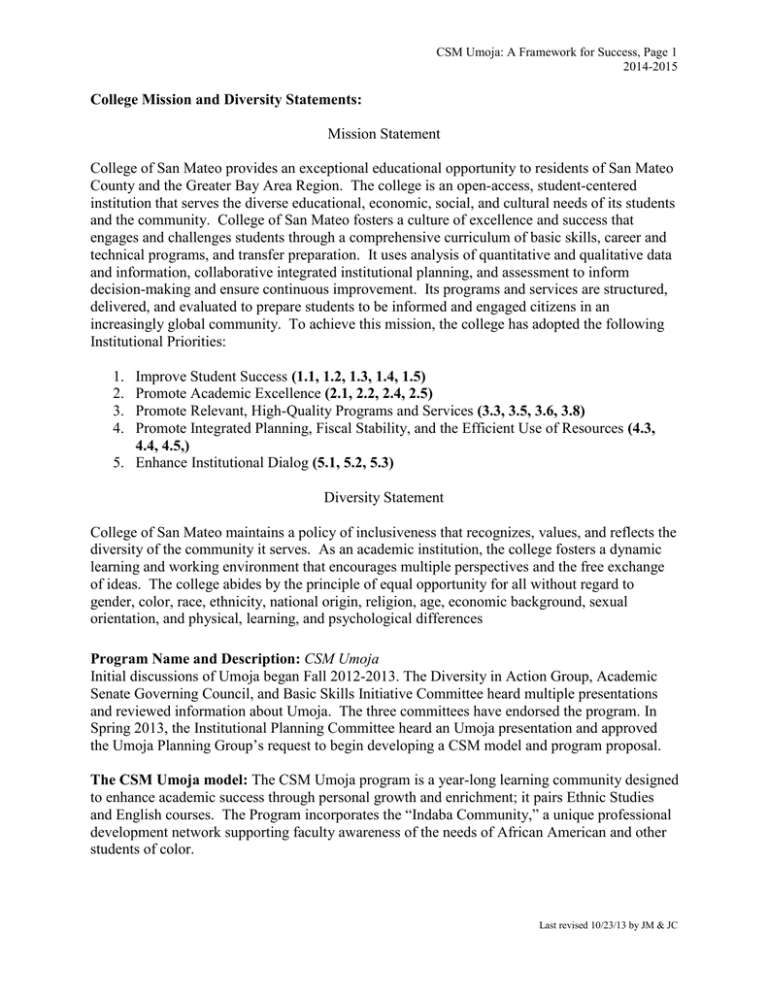
CSM Umoja: A Framework for Success, Page 1 2014-2015 College Mission and Diversity Statements: Mission Statement College of San Mateo provides an exceptional educational opportunity to residents of San Mateo County and the Greater Bay Area Region. The college is an open-access, student-centered institution that serves the diverse educational, economic, social, and cultural needs of its students and the community. College of San Mateo fosters a culture of excellence and success that engages and challenges students through a comprehensive curriculum of basic skills, career and technical programs, and transfer preparation. It uses analysis of quantitative and qualitative data and information, collaborative integrated institutional planning, and assessment to inform decision-making and ensure continuous improvement. Its programs and services are structured, delivered, and evaluated to prepare students to be informed and engaged citizens in an increasingly global community. To achieve this mission, the college has adopted the following Institutional Priorities: 1. 2. 3. 4. Improve Student Success (1.1, 1.2, 1.3, 1.4, 1.5) Promote Academic Excellence (2.1, 2.2, 2.4, 2.5) Promote Relevant, High-Quality Programs and Services (3.3, 3.5, 3.6, 3.8) Promote Integrated Planning, Fiscal Stability, and the Efficient Use of Resources (4.3, 4.4, 4.5,) 5. Enhance Institutional Dialog (5.1, 5.2, 5.3) Diversity Statement College of San Mateo maintains a policy of inclusiveness that recognizes, values, and reflects the diversity of the community it serves. As an academic institution, the college fosters a dynamic learning and working environment that encourages multiple perspectives and the free exchange of ideas. The college abides by the principle of equal opportunity for all without regard to gender, color, race, ethnicity, national origin, religion, age, economic background, sexual orientation, and physical, learning, and psychological differences Program Name and Description: CSM Umoja Initial discussions of Umoja began Fall 2012-2013. The Diversity in Action Group, Academic Senate Governing Council, and Basic Skills Initiative Committee heard multiple presentations and reviewed information about Umoja. The three committees have endorsed the program. In Spring 2013, the Institutional Planning Committee heard an Umoja presentation and approved the Umoja Planning Group’s request to begin developing a CSM model and program proposal. The CSM Umoja model: The CSM Umoja program is a year-long learning community designed to enhance academic success through personal growth and enrichment; it pairs Ethnic Studies and English courses. The Program incorporates the “Indaba Community,” a unique professional development network supporting faculty awareness of the needs of African American and other students of color. Last revised 10/23/13 by JM & JC CSM Umoja: A Framework for Success, Page 2 2014-2015 The CSM Umoja program supports the College’s diversity statement by fostering a learning and academic environment which values the experiences and perspectives of others. In this environment, diversity matters and is manifested through planning processes and faculty collaboration. The program model supports CSM Institutional Priorities 1, 2, 3, and 5. The CSM Umoja program is open to all students. Program Mission CSM Umoja supports students in completing a certificate, associate degree, and/or transfer requirements to a four-year college or university. CSM Umoja targets students who are interested in learning about African-American history, literature, and culture. Instructors who teach in the learning community use collaborative and other community building strategies to enhance students' learning potential in and out of the classroom. A. Statement of Need Data analysis from the Diversity in Action Group’s (DIAG) annual report confirms that there are significant disparities in student success in the categories of gender, age and ethnicity. The most glaring and consistent gaps are among ethnic groups and particularly among African Americans and Pacific Islanders. In nearly every assessment category, African Americans experience the least success whether it is course completion, transfer, or degree attainment. The DIAG report recommends that CSM consider establishing programs targeted to improve the student success rates of African Americans. African American students make up about 3% of CSM students or about 350. For the many who plan to take an associate degree or transfer, English, like math, is a major stumbling block. The English department has noted in its 2013 program review the need to address the low success rate (51%) and high withdraw rate (22.2%) among African American students in English courses. The department has made it a department goal for the coming year to “partner[ ] with other departments or programs to develop innovative ways to address low achievement rates specifically among African American, Pacific Islander, and Latino students.” (See English Program Review, 2013, Goal 2.) The Institutional Planning and Budget Committee has noted in its recent assessment of college themes and trends that the success rate of African American students is substantially lower than the college average. The state-wide Umoja Community practices and recommendations for program design have proven to be successful in supporting the academic success of African American students. (Please see Appendix A for Umoja Community’s Alignment with Student Success Task Force Recommendations.) Placement and Registration: According to Spring 2013 Core Program & Student Success Indicators, English registered 189 African American students (2011-2012 ), the second most of all departments on campus. (Math registered 201). Spring and Summer 2013 placement data record 106 African American students were eligible to place into English courses, with 57 students or about 53% placing into ENGL 838 or 848—the course level we will use in the first semester of the program. While we do not know the actual number of students who registered Last revised 10/23/13 by JM & JC CSM Umoja: A Framework for Success, Page 3 2014-2015 for ENGL 838 or 848 for Fall 2013, placement data suggest we have enough students eligible to form a cohort. B. Program Model Puente/Umoja Village o A designated space for Puente and Umoja students to meet Student Component (Student Success Task Force (SSTF) Recommendations 2.2, 2.4, 2.5, 3.4) o Complete application and intake form o Complete mandatory orientation o Take college placement tests o Develop a comprehensive Student Educational Plan o Meet with a counselor twice a semester o Meet regularly and as needed with program co-coordinators o Participate in core Umoja sponsored activities and campus service activities Instructional Component (SSTF Recommendations 2.2, 2.4, 3.4, 5.1) o Twelve unit course load o Instructional services: Supplemental Instruction, Writing Center tutoring, Learning Center peer tutoring, and Library o Ethnic Studies and English courses (To begin Fall 2014): Fall 2014 ETHN African American History and Culture ENGL 838 Intensive Comp and Reading Spring 2015 ETHN African American Cinema ENGL 105 Comp and Reading Support Services (SSTF Recommendations 2.2, 2.4, 2.5, 3.4, 5.1) o Designated counseling o Pathway to College/S.M.A.R.T o Workshops and fieldtrips o Student club or organization Administrative Component (SSTF Recommendations 1.1, 6.1, 6.2) o Budget o Staffing o Coordination duties Outreach/ Recruitment, including in-reach Develop work plan, including evaluation and assessment o Umoja advisory group, council, or committee Advise co-coordinators Assist in professional development planning for the Indaba Community of faculty and staff (The Zulu and Xhosa people of South Africa use indaba to refer to a gathering or meeting at which people come together to solve problems affecting them all.) Statewide Organizational Component (SSTF Recommendations 5.1, 6.1, 6.2) Last revised 10/23/13 by JM & JC CSM Umoja: A Framework for Success, Page 4 2014-2015 o o o o o o o o o o Professional Development (Annual Conference; Trainings; Regional Symposia) Pedagogical Practices (Umoja Practices) Memorandum of Understanding (MOU) Umoja Program Site Visits Umoja Community Governing Board Umoja Community Executive Committee Umoja Community Advisory Committee Transfer Agreements with Historically Black Colleges and Universities Mentor Guidelines Funding Strategies Indaba Community: Structure and Philosophy—The Indaba Community is made up of faculty and staff interested in working directly with Umoja program students and with each other. The Indaba Community also creates an organized first-year experience selection of courses. Indaba faculty and staff will be provided unique professional development opportunities to aid them in more successfully addressing the needs of African American students. As respected members of the Indaba community, faculty and staff will work together to support each other and the students they share. Indaba faculty and staff will be invited to attend all Umoja events. The students will ultimately become the link between faculty and staff alike as they come together to increase student success and opportunity (refer to Appendix B for Indaba diagram). The Indaba Community C. Program Operation and Budget Long-range Planning Work Plan: To be completed by co-coordinators and advisory group. Proposed Operational Budget: For a detailed account of budget allocations refer to Appendix C. Equipment and Technology: Determine the location of Puente/Umoja Village and number of Last revised 10/23/13 by JM & JC CSM Umoja: A Framework for Success, Page 5 2014-2015 student computer stations (Mac and/or PC) and printers for academic support. Consider the need for additional equipment, such as iPads, laptops, adaptive technology, document projectors, etc. Instructional Materials: Determine the need for adaptive technology and software to supplement course content. McGraw-Hill, LearnSmart and Connect software allows for self-assessment and directed learning in content and skills areas. Faculty Reassigned Time: Co-Coordination and Integrated Curriculum Dr. Gaines and the English instructor will co-coordinate the program and develop integrated course curricula for fall and spring semesters. Summer 2014, Co-coordination and program design begins: o 30 hours per week (15 hours each) for six weeks Fall 2014 – Spring 2015 and on-going co-coordination: o 6 units co-coordination—3 units each Classified Staff: Dedicated staff person, 15-20 hours per week to assist with clerical duties and monitor activity in the Puente/Umoja Village. Student Assistant: One or two student assistants to support co-coordinators and classified staff. Facilities: Determine space needs and location for Puente/Umoja Village. Professional Development: Professional development is essential for support staff, faculty co-coordinators, the Indaba Community, and others involved in the program. Other operating and/or recurring expenses: Plan for travel, training, conferences, annual consortium fee, and other related expenses. D. General Timeline By November 1: Ethic Studies course outlines submitted to COI By mid-December: Class Scheduling for Fall 2014 (Courses on interweaving days MWF & TTH) By July 30: Work plan for 2014-2015 By end of February: Marketing and Branding (website, flyers, brochure, etc.) Spring 2014 Semester: Begin Outreach and Recruitment Fall 2014 CSM Umoja Begins E. Program Assessment and Data Collection The Umoja co-coordinators will assess the program, summarizing outcome assessments and discussing areas in need of improvement in consultation with the advisory group. Course SLOs, Program SLOs (refer to Appendix D), and satisfaction surveys should be assessed on a semester basis. The Umoja co-coordinators will work with PRIE to develop a workable evaluation and assessment plan, incorporating success data. Last revised 10/23/13 by JM & JC CSM Umoja: A Framework for Success, Page 6 2014-2015 Appendix A Umoja Community’s Alignment with Student Success Task Force Recommendations SSTF Recommendation 1.1: Collaborate with K-12 education to jointly develop new common standards for college and career readiness that are aligned with high school exit standards. Umoja Practice: Continue to build k-12 alliances with underserved populations of students to build a bridge of hope and success. Students will take College Guidance courses and other college preparatory courses to prepare to enter local Umoja Programs in the community college system. SSTF Recommendation 2.2: Require all incoming community college students to: (1) participate in diagnostic assessment and orientation and (2) develop an education plan. Umoja Practice: Umoja Community students are required to take the college assessments; complete a program application/intake form; complete a mandatory program orientation; enroll in a guidance/college success course; complete a comprehensive student educational plan; meet with a counselor twice per semester; participate in core Umoja-sponsored program activities; complete the Free Application for Federal Student Aid (FAFSA) and Board of Governors Fee Waiver (BOGW) application. SSTF Recommendation 2.4: Require students whose diagnostic assessments show a lack of readiness for college to participate in support resources, such as a student success course, learning community, or other sustained intervention, provided by the college for new students. Umoja Practice: Umoja Community students participate in either a learning community or cohort model program that provides support services and appropriate intervention strategies. A college guidance or college success course serves as the anchor course for either program design. In addition, students are provided counseling services throughout their time on campus until they reach their educational goal. SSTF Recommendation 2.5: Encourage students to declare a program of study upon admission, intervene if a declaration is not made by the end of their second term, and require declaration by the end of their third term in order to maintain enrollment priority. Umoja Practice: Umoja Community students are required to complete and update a comprehensive student educational plan and are required to meet with a counselor twice per semester. Students declare a program of study at the initial counseling appointment and are provided follow-up counseling until they reach their educational goal. SSTF Recommendation 3.4: Community colleges will require students to begin addressing basic skills needs in their first year and will provide resources and options for them to attain the competencies needed to succeed in college-level work as part of their education plan. Last revised 10/23/13 by JM & JC CSM Umoja: A Framework for Success, Page 7 2014-2015 Umoja Practice: Umoja Community programs require students to complete their campus diagnostic assessments for placement recommendations into appropriate basic skills courses. Umoja Community programs with learning community models that include English and/or Math components immediately enroll students into the appropriate basic skills courses. SSTF Recommendation 5.1: Community colleges will support the development of alternatives to traditional basic skills curriculum and incentivize colleges to take to scale successful model programs for delivering basic skills instruction. Umoja Practice: Umoja Community programs are designed to address the needs of the student at the local level. Umoja Community programs provide mandatory tutoring, study hall sessions, an early alert warning system, mid-term progress reports; university and college tours; peer mentoring, cultural enrichment activities, student leadership development; service learning, mentoring, supplemental instruction, culturally-responsive curriculum and pedagogy to close the equity gap. Umoja provides students access to computer resources and incorporates social media to facilitate outreach and in-reach to new or continuing students. Several Umoja Community programs use accelerated basic skills models which significantly decrease the number of units and courses students must complete to reach transfer level work. These Umoja Community accelerated pathways demonstrate dramatic increase in students successfully completing transfer level math and English. SSTF Recommendation 6.1: Community colleges will create a continuum of strategic professional development opportunities, for all faculty, staff, and administrators to be better prepared to respond to the evolving student needs and measures of student success. Umoja Practice: Umoja Community provides annual professional development opportunities for faculty, staff and students including regional symposia, campus site visits, a week-long Summer Learning Institute and an annual conference. SSTF Recommendation 6.2: Community Colleges will direct professional development resources for both faculty and staff toward improving basic skills instruction and support services. Umoja Practice: Umoja Community provides regional workshops and trainings for faculty and staff in the Basic Skills Initiative. Umoja Community programs are directed to Basic Skills funding sources. SSTF Recommendation 7.3: Implement a student success scorecard. Umoja Practice: Umoja Community programs are given a special populations MIS data element which captures statewide data by individual programs on all of the matrixes suggested in the student success score card. Umoja Community programs are required to update their metric every year. Umoja Community programs already demonstrate better success rates along those matrixes as compared to African American students not in an Umoja Community program. Last revised 10/23/13 by JM & JC CSM Umoja: A Framework for Success, Page 8 2014-2015 Appendix B Indaba (zulu): “Coming together for a common cause” Professor A Professor B Professor D Biology In this diagram, the Indaba professional development community includes the Umoja instructors and four instructors that share Umoja students in their classes. Communication Studies English/Ethnic Studies Accounting Professor C Math Scaled up, the Indaba community could include up to 20 instructors in addition to the two Umoja LC instructors. Last revised 10/23/13 by JM & JC CSM Umoja: A Framework for Success, Page 9 2014-2015 Appendix C CSM Umoja: A Framework for Success Proposed Operational Budget (July 01, 2014 – June 30, 2015) OBJECT OF EXPENDITURE PROPOSED BUDGET BUDGET ACCOUNT NUMBER 1000 Replacement Cost Faculty Co-Coordinators 1259 (reassigned time at lecture 20,000.00 rate for 2013-2014 academic year) 1495 (special rate for planning & 11,000.00 program development; 30 hours for six weeks in Summer 2014) 2000 Non-Academic Salaries Instructional Aide II (48%, 11mos., Step 3) Counseling Hours 2210 2159 (80 hours for 2013-2014 21,000.00 5,600.00 academic year) 4000 Supplies & Materials Supplies 4510 2,000.00 5211 5213 5220 5310 5680 5690 5694 2,500.00 1,500.00 500.00 1,000.00 1,000.00 1,000.00 1,000.00 5000 Other Operating Expenses & Services Conference, In State Conference Expense, Students Mileage Dues/Memberships Contract Transportation Other Contracted Services Contracted Printing Services Total $68,100 Last revised 10/23/13 by JM & JC CSM Umoja: A Framework for Success, Page 10 2014-2015 Appendix D SLO Evaluation Rubric After successful completion of the CSM Umoja program coursework, students will be able to: SLO 1--Utilize campus resources to connect with the greater community. CATEGORY 3 Proficient 2 Basic 1 Non-Performance Writing Center and English 800 Center Math Resource Center Counseling Tutoring Financial Aid Last revised 10/23/13 by JM & JC
